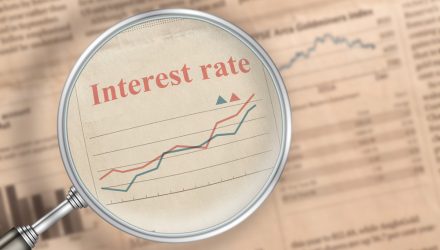It’s widely expected that the Federal Reserve will raise interest rates this month. Some market observers believe that is such a certainty that the only question is by how many basis points – 25 or 50 – the Fed lifts rates.
With rate hikes imminent, it’s not surprising that equity investors are jittery, but history indicates stocks don’t always decline when the Fed tightens. With the right strategies, investors can thrive as borrowing costs climb. Enter the ProShares Equities for Rising Rates ETF (EQRR).
EQRR follows the Nasdaq U.S. Large Cap Equities for Rising Rates Index, which is comprised of stocks that are positively correlated to rising rates. Data confirm EQRR’s methodology is working.
EQRR “has nearly doubled the return of the S&P 500 since the 10-Year U.S. Treasury’s lowest historical closing level in the summer of 2020,” according to ProShares research.
As some investors already know, some sectors are positively correlated to rising rates, others are negatively correlated and some are neutral. Translation: Sector attribution is meaningful in EQRR and the fund isn’t allocated to all of the 11 GICS sectors.
“Perhaps not surprisingly, financials have been at the top of the list as rising rates can lead to higher margins. In addition, energy and materials stocks both stand to benefit from the inflation that usually accompanies rising rates,” adds ProShares. “EQRR’s index has a total allocation of more than 80% to the financials, energy and materials sectors, while the S&P 500’s allocation to these totals only 17%.”
With a more than 46% combined allocation to energy and materials stocks, EQRR isn’t just a play on rising interest rates – it’s an equity-based avenue for investors looking to gain some inflation-fighting tools as well.
“If interest rates continue to rise in 2022, now may be the time to explore strategies for your large-cap equities sleeve,” concludes ProShares. “The goal of the fund (EQRR) is to provide relative outperformance, as compared to traditional U.S. large-cap indexes, such as the S&P 500, during periods of rising U.S. Treasury interest rates.”
Year-to-date, EQRR is proving durable as highlighted by a 2.53% while the S&P 500 is saddled with a double-digit loss.
For more news, information, and strategy, visit the Nasdaq Investment Intelligence Channel.
The opinions and forecasts expressed herein are solely those of Tom Lydon, and may not actually come to pass. Information on this site should not be used or construed as an offer to sell, a solicitation of an offer to buy, or a recommendation for any product.

